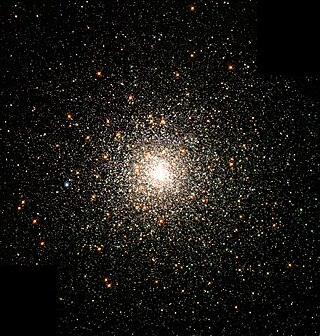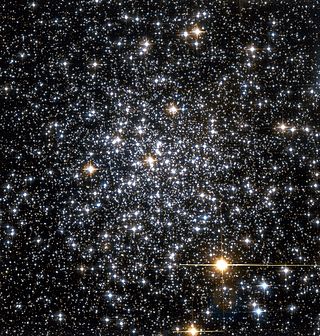
Messier 4 or M4 is a globular cluster in the constellation of Scorpius. It was discovered by Philippe Loys de Chéseaux in 1745 and catalogued by Charles Messier in 1764. It was the first globular cluster in which individual stars were resolved.

Messier 5 or M5 is a globular cluster in the constellation Serpens. It was discovered by Gottfried Kirch in 1702.

Messier 107 or M107, also known as NGC 6171, is a very loose globular cluster in a very mildly southern part of the sky close to the equator in Ophiuchus, and is the last such object in the Messier Catalogue.

Messier 2 or M2 is a globular cluster in the constellation Aquarius, five degrees north of the star Beta Aquarii. It was discovered by Jean-Dominique Maraldi in 1746, and is one of the largest known globular clusters.

Messier 80 is a globular cluster in the constellation Scorpius. It was discovered by Charles Messier in 1781, being one of his first discoveries.

Messier 19 or M19 is a globular cluster in the constellation Ophiuchus. It was discovered by Charles Messier on June 5, 1764 and added to his catalogue of comet-like objects that same year. It was resolved into individual stars by William Herschel in 1784. His son, John Herschel, described it as "a superb cluster resolvable into countless stars". The cluster is located 4.5° WSW of Theta Ophiuchi and is just visible as a fuzzy point of light using 50 mm (2.0 in) binoculars. Using a telescope with a 25.4 cm (10.0 in) aperture, the cluster shows an oval appearance with a 3′ × 4′ core and a 5′ × 7′ halo.

Messier 53 is a globular cluster in the Coma Berenices constellation. It was discovered by Johann Elert Bode in 1775. M53 is one of the more outlying globular clusters, being about 60,000 light-years (18.4 kpc) light-years away from the Galactic Center, and almost the same distance from the Solar System. The cluster has a core radius (rc) of 2.18 pc, a half-light radius (rh) of 5.84 pc, and a tidal radius (rtr) of 239.9 pc.

Messier 56 is a globular cluster in the constellation Lyra. It was discovered by Charles Messier in 1779. It is angularly found about midway between Albireo and Sulafat. In a good night sky it is tricky to find with large (50–80 mm) binoculars, appearing as a slightly fuzzy star. The cluster can be resolved using a telescope with an aperture of 8 in (20 cm) or larger.

Messier 62 or M62, also known as NGC 6266, is a globular cluster of stars in the south of the equatorial constellation of Ophiuchus. It was discovered in 1771 by Charles Messier, then added to his catalogue eight years later.

Messier 70 or M70, also known as NGC 6681, is a globular cluster of stars to be found in the south of Sagittarius. It was discovered by Charles Messier in 1780. The famous comet Hale–Bopp was discovered near this cluster in 1995.

Messier 71 is a globular cluster in the small northern constellation Sagitta. It was discovered by Philippe Loys de Chéseaux in 1745 and included by Charles Messier in his catalog of non-comet-like objects in 1780. It was also noted by Koehler at Dresden around 1775.

Messier 92 is a globular cluster of stars in the northern constellation of Hercules.

NGC 5466 is a class XII globular cluster in the constellation Boötes. Located 51,800 light years from Earth and 52,800 light years from the Galactic Center, it was discovered by William Herschel on May 17, 1784, as H VI.9. This globular cluster is unusual insofar as it contains a certain blue horizontal branch of stars, as well as being unusually metal poor like ordinary globular clusters. It is thought to be the source of a stellar stream discovered in 2006, called the 45 Degree Tidal Stream. This star stream is an approximately 1.4° wide star lane extending from Boötes to Ursa Major.

NGC 5986 is a globular cluster of stars in the southern constellation of Lupus, located at a distance of approximately 34 kilolight-years from the Sun. It was discovered by Scottish astronomer James Dunlop on May 10, 1826. John L. E. Dreyer described it as, "a remarkable object, a globular cluster, very bright, large, round, very gradually brighter middle, stars of 13th to 15th magnitude". Its prograde–retrograde orbit through the Milky Way galaxy is considered irregular and highly eccentric. It has a mean heliocentric radial velocity of +100 km/s. The galacto-centric distance is 17 kly (5.2 kpc), which puts it in the galaxy's inner halo.

NGC 1261 is a globular cluster of stars in the southern constellation of Horologium, first discovered by Scottish astronomer James Dunlop in 1826. The cluster is located at a distance of 53 kilolight-years from the Sun, and 59 kilolight-years from the Galactic Center. It is about 10.24 billion years old with 341,000 times the mass of the Sun. The cluster does not display the normal indications of core collapse, but evidence suggests it may have instead passed through a post core-collapse bounce state within the past two billion years. The central luminosity density is 2.22 L☉·pc−3, which is low for a globular cluster. Despite this, it has a Shapley–Sawyer Concentration Class of II, indicating a dense central concentration.

NGC 6352 is a globular cluster of stars in the southern constellation of Ara, located approximately 18.3 kly from the Sun. It was discovered by Scottish astronomer James Dunlop on May 14, 1826. The cluster has a Shapley–Sawyer Concentration Class of XI:. A telescope with a 15 cm (5.9 in) aperture is required to resolve the stars within this loose cluster.

NGC 6584 is a globular cluster in the constellation Telescopium that lies near Theta Arae and is 45000 light-years distant. It is an Oosterhoff type I cluster, and contains at least 69 variable stars, most of which are RR Lyrae variables: 46 stars were identified as RRab variables; 15 as RRc variables, 1 RRe variable, 4 eclipsing binaries and 3 long period variables. NGC 6584 is about 4 kpc from the Galactic center and about 2.7 kpc from the Galactic plane.

NGC 4147 is the New General Catalogue identifier for a globular cluster of stars in the northern constellation of Coma Berenices. It was discovered by English astronomer William Herschel on March 14, 1784, who described it as "very bright, pretty large, gradually brighter in the middle". With an apparent visual magnitude of 10.7, it is located around 60,000 light years away from the Sun at a relatively high galactic latitude of 77.2°.

NGC 6441 is a globular cluster in the southern constellation of Scorpius. It was discovered by the Scottish astronomer James Dunlop on May 13, 1826, who described it as "a small, well-defined rather bright nebula, about 20″ in diameter". The cluster is located 5 arc minutes east-northeast of the star G Scorpii, and is some 43,000 light-years from the Sun.

NGC 5053 is the New General Catalogue designation for a globular cluster in the northern constellation of Coma Berenices. It was discovered by German-British astronomer William Herschel on March 14, 1784 and cataloged as VI-7. In his abbreviated notation, he described it as, "an extremely faint cluster of extremely small stars with resolvable nebula 8 or 10′ diameter, verified by a power of 240, beyond doubt". Danish-Irish astronomer John Louis Emil Dreyer reported in 1888 that the cluster appeared, "very faint, pretty large, irregular round shape, growing very gradually brighter at the middle".























